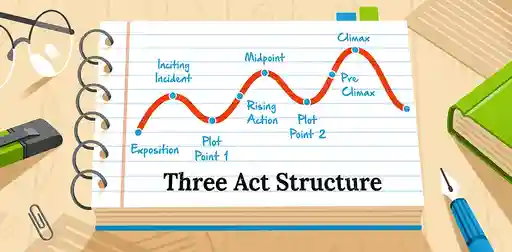How to Use the Three-Act Story Structure
A Little Background
I used to be a "pantser," meaning I would write my novels by the seam of my pants. After doing some research on YouTube about how to combat writers block, I stumbled across a lady named Abbie Emmons. She had a ton of videos about this thing called "The Three-Act Story Structure." I was amazed at the idea of planning everything before you start writing, and, to my surprise, lots of well-known authors and stories outline and/or use the three-act structure. For example, The Hunger Games uses this outline. So, to pay it forward, I'm breaking down the different plot points from this story structure and how to use each one for your book.
The Three-Act Story Structure
Act 1-Set Up (First 25% of your story/word count)
Hook
Pretty much the exposition: who the main character is, their daily life, their desires, their fears, etc.
Inciting Incident
Arguably, the most important plot point. This story beat is the moment your protagonist has to go on an adventure (doesn't need to be a literal adventure) to achieve some kind of goal. This could be a fear-based goal or a goal to save their hometown. Not sure, it's your story. You come up with that!
1st Plot Point
This is the protagonist's first major decision. What choice are they going to make in regard to the goal they want to achieve? For example: In the Hunger Games by Suzanne Collins, Katniss Everdeen chooses to volunteer herself to be in the titular games in place of her sister. Another example: Dorthy Gale, from The Wizard of Oz, chooses to ease down the road in search for Emerald City.
1st Pinch Point
This plot point, though optional, can give an emotional impact to your story. The antagonistic force grows closer. The antagonist doesn't need to be a person; it could be the protagonist's fear!
Act 2- Confrontation (Next 50% of your story/word count)
Pre-Midpoint Reactionary Hero
Essentially, the rising action. The protagonist goes on the journey to execute their plan to achieve their goal. This plot point is filled with roadblocks, new surroundings, and challenges that the protagonist will have to face.
Midpoint
It's not necessary for a pivotal moment to have some grandiose and bizarre turn of events. Actually, all it takes for a game-changing midpoint to change the protagonist's objective is to surprise them.
Post-Midpoint Action Hero
Determine the protagonist's response to the plot twist. It pushes people even more outside of their comfort zone and presents a fresh, unanticipated challenge—sort of like another inciting occurrence. Give your protagonist a game plan and a feeling of direction for the future. Because they can predict what MIGHT happen, your readers are curious as to what happens next.
2nd Pinch Point (optional)
Recall that your "opposition" doesn't always have to be a real antagonist or person; it could simply be the protagonist's persistent delusion, waiting to strike in act 3. You want to offer the reader a taste of the main "opposition" your protagonist will encounter at the conclusion of your story at this point in the narrative.
Act 3- Resolution (Last 25% of your story/word count)
Supposed Victory (optional)
The protagonist is making progress with their revised plan and is optimistic that they will win. Alternatively, it's possible that they have already surmounted the most minor obstacles and are confident in their strategy. They had no idea that calamity is approaching.
Disaster/Dark Moment
Root the catastrophe in your protagonist's deepest phobia and disbelief to bring them to their knees. Even when it might be a horrible experience for anyone, make it particularly awful for your protagonist because of their fear and skepticism.
Aha Moment
This is the most significant turning point in your entire narrative. Your protagonist gets an epiphany, or a "aha" moment, when the catastrophe has driven them to their knees. All of a sudden, they see how their ignorance and fear have caused them to make poor choices in every area of their lives. They recognize how mistaken they were, but more importantly, they know that in order to reach their objective—true happiness—they must get over their fear and choose the RIGHT course of action.
Climactic Confrontation/Victory
Everyone has been waiting for this moment, when the protagonist would encounter their greatest obstacle to date. It's a true test of their character, and the way they handle the confrontation shows how much their journey has changed them. It's now time for your protagonist to triumph in the external conflict, having already won the inside one.
Resolution/End
Here's where all the loose ends are connected. There should be no unanswered questions or gaps in the reader's knowledge. In case the book is a part of a series, you can consider ending on a suspenseful note by substituting another “plot twist” for the “victory” story beat. In the event that the book is stand-alone, ensure that the reader's queries are addressed on the last page.
Final Thoughts
I hope this outline helps you! If not, there are sooooo many different story structures for you to try. Don't limit yourself to this structure if you find it's not working. As long as you try to outline your story before you begin writing, that's the most important thing.
Thanks for reading!
Thanks for reading this blog post. Do you have any writing goals this quarter or month? What are they? How far are you in your current work in progress? What's it about? Leave your answers down in the comments section! If there's a topic you'd like to discuss, leave that in the comments as well. If there's a specific book you'd like me to review on this blog, leave that in the comments too! I'll see you next week with another review! Bye!

Comments
Post a Comment